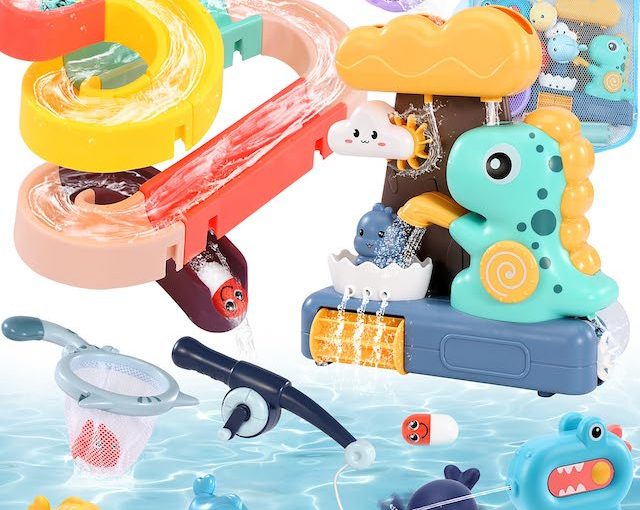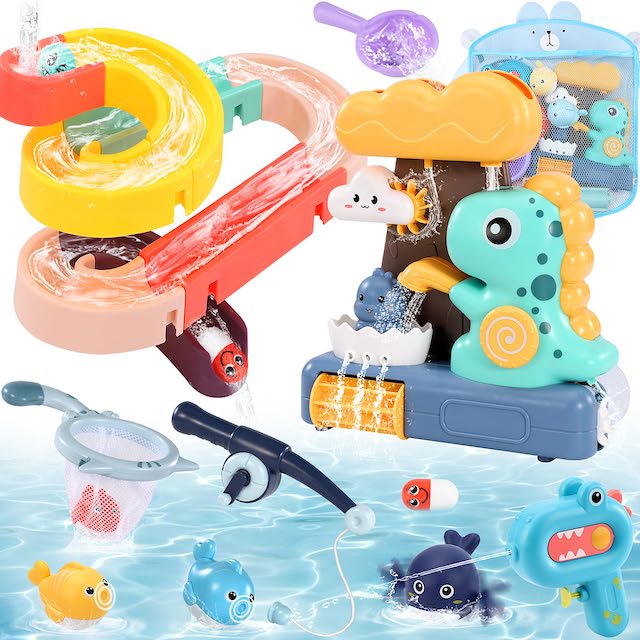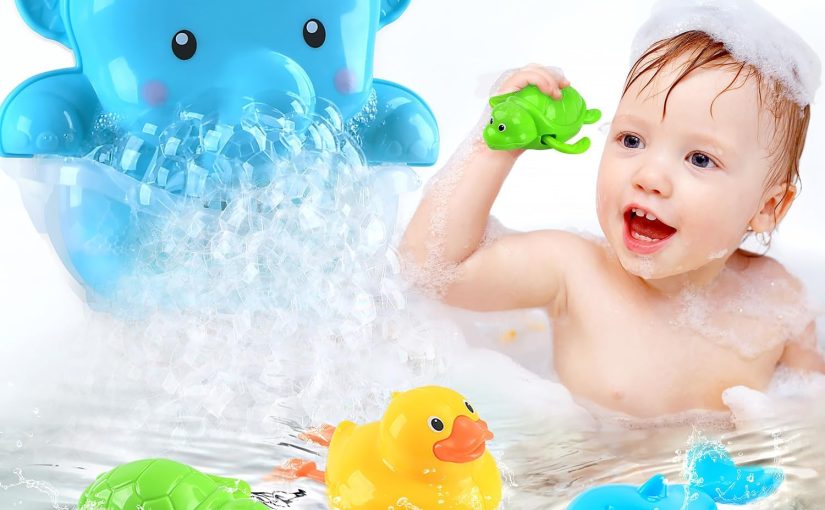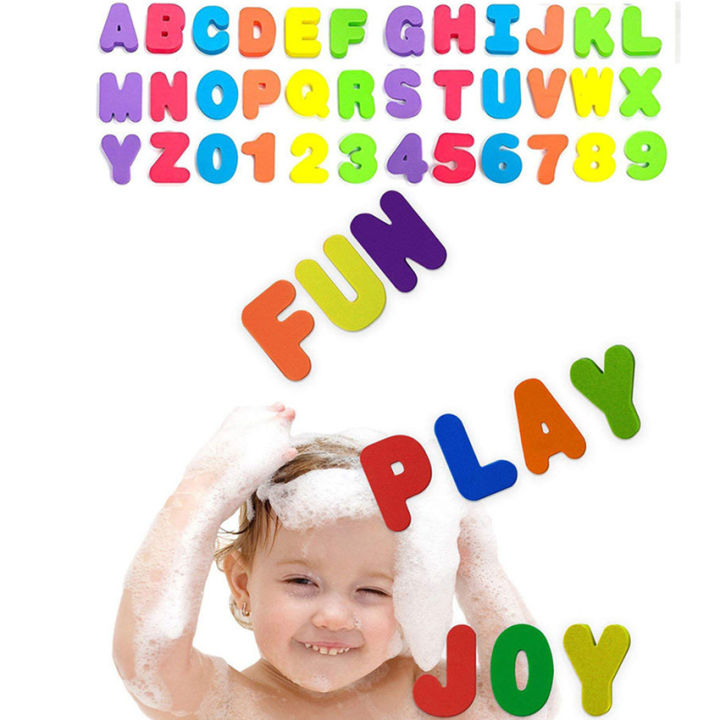The Benefits of Bath Time Play
Bath time for toddlers offers more than just cleanliness. It’s a discovery zone. Here’s why bath time play is so beneficial:
- Stimulation for the Senses: Bath toys for 2-year-olds arouse multiple senses. They touch, hear, and see new things.
- Boosts Motor Skills: Grasping and manipulating bath toys helps toddlers strengthen hand-eye coordination.
- Encourages Creativity: Colorful and imaginative toys spur creativity during bath play.
- Improves Learning: Bath time can double as learning time. Identifying shapes and numbers with toys enhances early education.
- Soothes and Relaxes: Playing in water can calm a fussy toddler, preparing them for bedtime.
- Enhances Social Skills: Sharing toys with siblings or parents during bath builds social abilities.
By integrating bath toys for 2 year olds into water play, you can turn a routine bath into a fun and enriching experience.
Essential Features of Toddler-Friendly Bath Toys
Selecting the right bath toys for 2-year-old toddlers involves considering a few essential features. Here’s what to look for:
- Durability: Toddlers can be tough on toys. Pick sturdy, long-lasting materials.
- Safety: Ensure toys are free from sharp edges and small parts. They should be non-toxic and BPA-free.
- Sensory Appeal: Opt for toys with bright colors, varied textures, and fun sounds. They can keep toddlers engaged and entertained.
- Educational Value: Some toys help teach shapes, numbers, or cause-and-effect. These toys can both entertain and educate.
- Ease of Cleaning: Bath toys are prone to mold and mildew. Look for toys that are easy to clean and dry.
- Size and Fit: Ensure toys are the right size for little hands to grasp and manipulate.
These features guarantee that bath toys for your 2-year-old are not only enjoyable but also supportive of their overall development while maintaining safety as a priority.
Top Bath Toy Categories for 2-Year-Olds
When it comes to bath toys for 2-year-olds, variety is key. Here are top bath toy categories that cater to the playful and curious nature of toddlers:
- Floating Toys: Ducks, boats, and foam letters float on water, offering endless fun.
- Squirt Toys: These toys can spray water, making bath time lively and interactive for toddlers.
- Sensory Balls: Balls with different textures encourage exploration and sensory development.
- Stackables and Pouring Cups: Cups and toys stack or pour water, teaching toddlers about cause and effect.
- Bath Books: Waterproof books with colorful illustrations engage toddlers’ imagination and make for a quiet bath time activity.
- Musical Toys: Instruments designed for the bath help develop an ear for music and rhythm.
- Bath Crayons and Paints: Safe for the tub, these toys allow toddlers to express their creativity on the bath walls.
Choosing bath toys that fit in these categories ensures that your toddler has a variety of play options. They won’t just get clean; they’ll have a chance to learn, create, and enjoy every moment in the tub.
Safety Considerations for Toddler Bath Toys
When choosing bath toys for 2 year old toddlers, safety is paramount. Here are key safety tips:
- Check for Choking Hazards: Toys should be large enough to not fit entirely in a toddler’s mouth.
- Non-toxic Materials: Toys must be free from harmful chemicals. Look for non-toxic, BPA-free labels.
- No Sharp Edges: Toys should be smooth with no rough edges to prevent cuts and scrapes.
- Water-tight Seals: Ensure toys with openings are sealed well to avoid trapping water and growing mold.
- Temperature Sensitivity: Some toys can indicate if the bathwater is too hot for delicate skin.
- Age-appropriate Design: Select toys that match the developmental stage of your 2-year-old.
Safety must always come first to ensure a fun and secure bath time experience for toddlers.
Educational Bath Toys for Cognitive Development
Choosing the best bath toys for a 2-year-old isn’t just about fun; it’s also about fostering cognitive development. When toddlers play with the right toys during bath time, they unlock new skills and understandings. Look for toys that encourage thinking and problem-solving to help with cognitive growth.
Puzzle Toys: Bath toys that come in parts, like puzzles, boost problem-solving skills. Toddlers learn to fit pieces together, understanding shapes and spatial relationships. Choose large, easy-to-handle pieces to prevent swallowing hazards.
Color-Matching Games: These toys promote color recognition and the concept of matching. Toddlers can sort toys by color, enhancing their capacity to differentiate and identify various hues.
Counting Toys: Toys with numbers teach basic counting skills. With waterproof books or floating numbers, toddlers practice saying and recognizing numbers.
Memory Games: Simple games that require remembering where objects are or matching pairs can be great for enhancing memory during bath time. Look for toys with brightly colored parts that can float and are easy to grasp.
Letter and Word Toys: Foam letters that stick to the bath walls help toddlers begin letter recognition and word formation. This is a playful step towards literacy. Pick large letters without detachable small parts.
By incorporating educational bath toys into your toddler’s routine, you turn bath time into a learning hub. Each splash offers a chance to learn something new while having fun.
Tips for Organizing and Cleaning Bath Toys
Keeping bath toys tidy and hygienic is a must for your toddler’s health and safety. Here are some effective tips:
- Designate a Toy Basket: Use a basket or a net bag to store bath toys. This keeps the toys in one place.
- Regular Cleaning Routine: Establish a schedule for washing bath toys to prevent mold and mildew. Do this at least once a week.
- Air Dry Toys: Post bath, allow toys to air dry completely. This reduces the chance of mold growth.
- Vinegar Soak: Every so often, soak bath toys in a mixture of vinegar and water. This naturally disinfects the toys.
- Keep Fewer Toys: Less is more. Having fewer toys makes organizing and cleaning quicker.
- Rotate Toys: Give toys a break. Rotating them out ensures they dry fully and extends their life.
- Check for Damage: Regularly inspect toys for cracks or damage where water could enter and mold could form.
By keeping bath toys for your 2-year-old well-organized and clean, you ensure safer and more enjoyable bath times.
Making Bath Time Fun with DIY Toy Ideas
The best bath toys for a 2 year old often combine fun with learning. If you’re looking for cost-effective ways to spice up your toddler’s bath time, DIY toy ideas can be a fantastic choice. Here are some simple yet engaging DIY bath toy ideas:
- Bottle Squeeze Fun: Take clean, empty plastic bottles and turn them into squirt toys by piercing small holes in the lids.
- Floating Shapes: Cut different shapes out of colorful foam sheets that can float on the water’s surface.
- Homemade Boats: Create boats using empty yogurt containers or margarine tubs. Decorate them with waterproof markers.
- Waterproof Puppet Show: Craft fun characters out of sponges or washcloths. They make for an entertaining puppet show.
- Discovery Bottles: Fill clear plastic bottles with water, glitter, and other non-toxic, waterproof items to shake and explore.
- Sensory Bags: Seal hair gel, food coloring, and small waterproof toys inside zip lock bags for a mess-free sensory experience.
These simple ideas not only enhance the joy of bath time but also tap into your toddler’s creativity and problem-solving skills. Plus, they encourage parents and children to engage in a fun DIY activity together, potentially improving their bond. Remember to supervise your children closely during bath time to ensure their safety with any toys, including DIY ones.
The Best Bath Toys for 2-Year-Olds: Our Picks
Finding the perfect bath toys for a 2-year-old can be daunting. With so many options, it’s essential to pick toys that are not just fun but also safe and beneficial for development. Here are some of the best picks that meet our outlined criteria:
- Interactive Bath Books: These colorful waterproof books are both educational and entertaining, contributing to language skills and a love for reading.
- Floating Foam Letters: Ideal for the start of alphabet familiarity, they stick to walls when wet, making learning interactive.
- Stackable Cups: Cups that stack and pour help teach basic physics like cause and effect, balance, and volume.
- Rubber Ducks and Boats: Classics that never get old, they promote imaginative play and can teach about buoyancy.
- Squirt Toys: Water-squirting toys bring laughter and fun. They also enhance fine motor skills and hand-eye coordination.
- Bath Crayons: Bath-safe crayons encourage creativity and can be easily washed off walls.
When selecting from these top bath toys for your toddler, ensure each toy matches criteria for safety, stimulation, and hygiene. With these carefully chosen toys, bath time can be a highlight of your child’s day; a time filled with fun, learning, and development.







